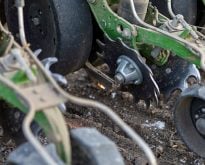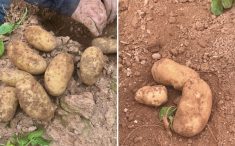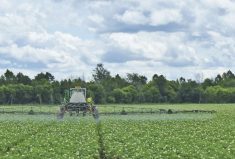[UPDATED: April 4, 2022] Few things grab a producer’s attention faster than high yields, and for a lot of good reasons. Yield is the money-maker, a point of pride and the only real metric that matters. But this winter it may be getting a second look as producers learn more about how to use nitrogen and other nutrients.
Agriculture is also more environmentally aware. There’s a greater focus on “doing more with less” and adhering to the 4R Stewardship principles (the Right source, the Right rate, at the Right time and in the Right place).
That said, uptake of environmentally smart nitrogen (ESN) has been slower than some of its backers expected, mostly, they suspect, due to it being “something different” and because of availability in some regions. But its practicality and efficacy in parts of Canada are hard to argue.
Read Also

Sensing the soil: Root cell research finds ‘stress hormone’
Research into how root cells react to soil stressors could help plants better adapt to changes in their climate.
Dr. Tarlok Singh Sahota began working with ESN in 2006 at what was then the Thunder Bay Agricultural Research Station, now the Lakehead University Agricultural Research Station (LUARS). He has studied the long-term effects of the product and has a following among producers in northwestern Ontario, who use ESN alongside manure, urea and ammonium sulphate, and when applying blends with urea (2:1 ratio on N basis), he has seen improvement in yields and quality.
“Even where yield improvement wasn’t significant by the use of ESN alone compared to urea, ESN resulted in improvements of produce quality, especially protein content in grains and forages,” says Sahota, LUARS director.
Within his research he found:
- Urea + ESN at 100 kg of N per hectare (89 lbs. of N per acre) provided as much forage yield and protein content in MasterGraze corn as urea at 150 kg of N per ha (139 lbs. of N per acre).
- In canola, urea + ESN at 120 kg of N per ha (107 lbs. of N per acre) gave as much seed yield as urea at 180 kg of N per ha (161 lbs. of N per acre).
Sahota contends that ESN is beneficial on all crops and crop rotations, and he notes growers in northwestern Ontario tend to have more diverse cropping plans than those in other parts of the province. Most farmers in the Lakehead region and many farther west towards the Manitoba border have livestock where they apply manure in significant quantities along with ammonium sulphate, urea and ESN.
“I’ve been observing corn maintaining green leaves right from top to bottom until harvest at Thunder Bay, which can’t happen without consistent N supply to crop plants,” says Sahota. “Farmers from southern Ontario often complain about paling of lower leaves. I believe that with the combination of manure, ammonium sulphate, urea and ESN, there’s no need for split applications of N to corn.”
Sahota also suggests growers in southern Ontario could increase their ESN in the urea + ESN blends to 2:1 ESN to urea.
That’s a big advantage for producers in the northwest, where growing seasons tend to be cooler and shorter, even with longer day-length periods during late spring and early summer. In silage corn, Sahota found that ESN on its own provides less of a yield boost than just urea in a cooler climate. Conversely, ESN alone yielded higher than urea in a warmer year.
“ESN has worked well in silage corn in blends with urea and the proof is the practice is adopted by our farmers,” he adds. “The use of ESN in Thunder Bay has increased and an advantage was obtained in all crops.
Farm tested
Ryan Jaspers began using ESN about five years ago on his family dairy operation near Slate River just west of Thunder Bay. For the past three years, he’s been blending ESN with mono-ammonium phosphate (MAP), putting it in-furrow at seeding in wheat and barley. He uses a planter for canola and corn with a liquid starter system.
“For those crops, we broadcast along with urea and incorporate pre-plant in the spring,” says Jaspers, who farms along with his father, Fritz. They wanted to start using ESN because the research station (LUARS) had been using it with good results. “Plus, as we push our crops for higher yields, lodging becomes a big concern as we have always put all our fertility on pre-plant. We talked about splitting nitrogen, which would either be broadcast urea in-crop and then rain or dribble UAN on.”
They decided to give ESN a try because its slow release would provide the same effect as splitting nitrogen while saving a pass in the field.

Jaspers does have two concerns about ESN, one of which relates to timing: When in the season does it release? A lot of that, he notes, depends on how it was handled before it goes to the field. Is it well-coated for slower release? And what about the environment — is it dry, wet, lots of rain, little or no rain? But Jaspers is quick to note that other methods for splitting nitrogen have their own risks as well.
The second concern is pricing, which may affect its adoption by some growers. ESN is more costly per ton than urea, which Jaspers concedes can compound the unknown timing factor.
“When you split nitrogen in-crop, you can make a decision on how much nitrogen the crop may need based on the growing season and condition of the crop,” he says. “But if you put everything up front, you’re committed to that level of fertility if you don’t plan to go in-season to top up the crop. We’ve seen some good yields in the past few years and ESN is one piece of all that goes into growing a good crop for us.”
Why not ESN in the south?
Asked why ESN has been more readily adopted in Ontario’s northwest and the Prairies than to the east, Ray Dowbenko says much of it comes down to availability. Uptake has been greater in Western Canada because the fertilizer plant built in Carseland, Alta., has been sold out since its opening, with additional exports to the northern-tier Great Plains states.
“It’s product supply and availability but also where sales representatives and marketing have been concentrated closer to home,” says Dowbenko, an independent agronomist from Calgary and formerly with Nutrien. “There hasn’t been a lot of work in the East, although we’ve had trials with different groups, distributors and retailers in Eastern Canada, but the focus of the company has been in Western Canada and the northern states.”
According to Dowbenko, the choice of crops for use of ESN is a determinant as well. First approved for forage crops in Canada in 2005, and in 2006 for all food crops in Western Canada, ESN has seen better uptake in cereals and canola and less for grain corn.
“If growers can make one application of a controlled-release fertilizer and carry the crop throughout the season, it precludes making split applications, which follow good 4R nutrient stewardship management practices,” he says. “With the controlled-release product, you can make one application, either pre-season or in-season and carry that crop throughout the year, and not need to make the split application.”
With UAN, 28 per cent or 32 per cent, growers — especially of corn in Ontario — are accustomed to making split applications and retailers are set up for that practice. Plus most farmers understand what urea nitrogen is, and they can buy a truckload and take it home.
Timing is everything
There’s also some adjustment in application timing, East versus West. Dowbenko has made recommendations for fall-applied ESN to winter wheat — negating applications the following spring prior to green-up — yet the same practice doesn’t always apply in southern Ontario. If the ground doesn’t freeze until January, ESN may release at a time when the crop can’t use it.
But in corn, growers in Southern Ontario can benefit once they assess optimum timing for the crop. Dowbenko cites the six- to eight-leaf stage as having the largest nitrogen demand and growers need to determine when ESN would release sufficient amounts of N to coincide with that stage. That’s a product of planting date as well as soil moisture levels at the start of the season, yet once that timing is established, there are more options for applications.
“The idea you can fall-apply it, spring-apply it, put it in the seed row, use different blends — it’s all a matter of understanding what time your crop needs nitrogen,” says Dowbenko. “If you have hot, humid environments and high rainfall conditions, it’s going to protect the nitrogen, and that’s where you want to use this product. The best fit is where you have conditions for loss.”
*Update: The article was amended to eliminate possible confusion over ESN marketing plans for Canada.
















